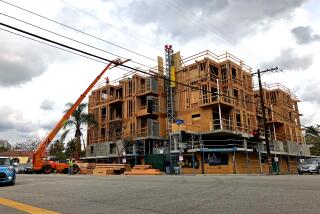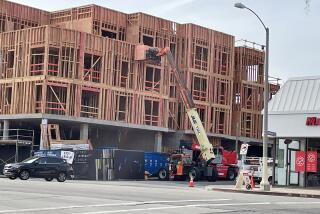Filner, McCarty Plan for Growth Linked to Facilities Is Called Too Weak by Critic
- Share via
San Diego City Council members Bob Filner and Judy McCarty, refining the growth-management plan they authored in January, on Wednesday defined the basic levels of public services and facilities they believe should be provided in a community before new home construction would be allowed.
Claiming that the new, measurable standards will make the council more accountable for future development, the pair called for specified levels of fire protection, parks, roads, recreation centers, libraries and schools before home building would be allowed.
Under the plan, council would be given the discretion in urbanized areas to allow a development even if adequate facilities are not available. That position is a retreat from the earlier, tougher position that would have prohibited development if the facilities were not available.
‘Have to Justify It’
“Sure, five votes (on the 9-member council) can do anything,” Filner said. “But if we do it . . . we have to justify it.”
On Jan. 31, the council adopted the Filner-McCarty plan as the approach it will take to managing growth and protecting sensitive topography. Unlike two growth-control plans rejected by voters Nov. 8, the plan abandons numerical growth caps in favor of the assumption that public facilities be available at the time they are needed.
Today, the council will begin to grapple with the tough questions arising out of that approach: whether to halt development in communities until public facilities are built and how to pay for the huge shortfall of those facilities in urbanized areas. In addition, it will look at ways to monitor the adequacy of those facilities over the years.
Peter Navarro, chairman of Prevent Los Angelization Now!, a slow-growth group, said that Wednesday’s Filner-McCarty memo is “vintage City Council, which means that it is riddled with weak language and potential loopholes.” Navarro criticized the provision allowing the council to approve development even if facilities are inadequate and the plan’s failure to take into account new growth’s impact on freeway traffic, water availability and sewage treatment needs.
Back to Ballot Again?
Navarro’s group, formerly known as Citizens for Limited Growth, is writing its own growth-management plan and may attempt to put it on the ballot for voter approval. The group’s two slow-growth plans were defeated at the polls last year.
Wednesday’s Filner-McCarty memo suggests specific standards for “basic facilities”--those that no community should be asked to do without. For example, the council members want fire stations spaced to ensure a maximum six-minute response time to any alarm. They would require a population of 18,000 to 20,000 people before a branch library would be built.
Similar standards are provided for roads, variously sized parks and streets, and other facilities. Communities desiring the luxury of “enhanced facilities,” a larger than usual library, for example, would be required to devise ways of paying for them, the council members said.
In the city’s northern, “urbanizing” tier, where large-scale projects are still possible because vacant land is available, developers would be required to construct basic facilities and have them ready when residents move in. In the city’s “urbanized” inner-city, where $645 million in facilities are needed to catch up with past growth, Filner and McCarty believe that it is the city’s duty to pay for the shortfall.
More to Read
Sign up for Essential California
The most important California stories and recommendations in your inbox every morning.
You may occasionally receive promotional content from the Los Angeles Times.










